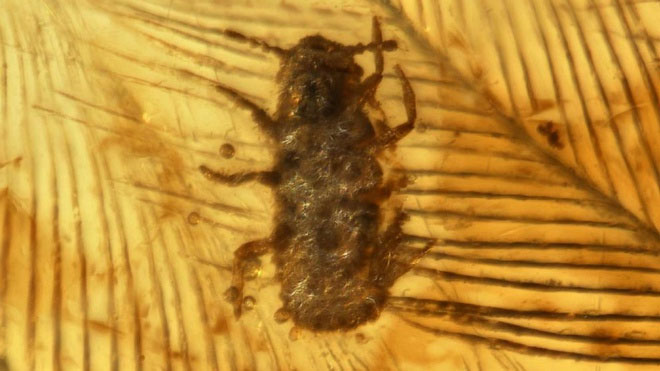Found amber fur dinosaur, ancient lice 99 million years old
Scientists have unearthed an amber containing feathers of dinosaurs along with many ancient lice nearly 99 million years ago.
Prior to the discovery, the oldest louse fossil ever found was 44 million years old, about 22 million years after the end of the dinosaur era, according to Inside Science.
Scientists studied two pieces of amber, excavated in the Hukawng valley, northern Myanmar. They were donated by amber to science in 2016. Radioisotope analysis revealed that the specimen was about 99 million years old.
The origin and evolution of this parasite remains a mystery. Deciphering how this species evolved in tandem with its host could reveal new information about ancient species that fossils do not fully represent.

Ancient louse Mesophthirus angeli crawled on the feathers of dinosaurs, dating back to the Cretaceous.(Photo: Inside Science)
Amber consists of 2 feather patterns. Based on comparisons with fossils that have been unearthed, these are dinosaur feathers, not ancient birds , according to Chung Kun Shih, an expert at the Smithsonian's National Museum of Natural History.
The scientists also found 10 insects in the form of 'pupae ', immature, located in amber. The largest one is 230 microns long, 100 microns larger than the average human hair diameter. Through analysis, the scientists found that these creatures have a similar body structure to modern lice. They named the newly discovered creature Mesophthirus Engeli.
Mesophthirus has a strong jaw. One of the two feathered specimens shows signs of being bitten, similar to the way lice parasitize on the feathers of modern birds. This suggests that the feathered parasites evolved during the mid-Cretaceous period of the Great Mesozoic, when feathered dinosaurs and ancient birds appeared.
- Discover the secret of a huge ancient louse
- Ancient lice trapped in amber 100 million years
- The dinosaur tails remain intact in the amber mass of 99 million years
- Discovered the dead body stuck in amber 99 million years
- Amazingly discovered about the 100 million-year-old bird in amber
- India discovered amber plates dating back 50 million years
- The discovery of gecko fossils lies in amber dating from nearly 100 million years
- Mushrooms are 50 million years old in amber mass
- The flower is 100 million years old as freshly picked in amber
- 9-year-old boy found fossil dinosaur eggs 66 million years
- Discovering millions of years of amber masses with great value
- The tick sucked the whole blood of dinosaurs 99 million years in amber grave
- Found the dinosaur skull dating to 65 million years in the United States
 Discovered an ancient centipede fossil 99 million years old
Discovered an ancient centipede fossil 99 million years old Discovered bat-like dinosaurs in China
Discovered bat-like dinosaurs in China Discovered a 200-year-old bronze cannon of the coast
Discovered a 200-year-old bronze cannon of the coast Discover 305 million-year-old spider fossils
Discover 305 million-year-old spider fossils